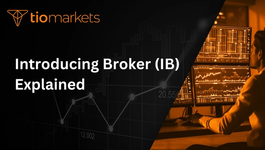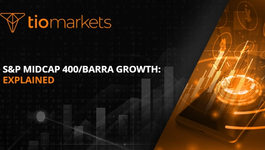Fama–French three-factor model: Explained | TIOmarkets
BY TIOmarkets
|July 8, 2024The Fama–French three-factor model is a highly influential model in the field of finance and trading. It was developed by Nobel laureate Eugene Fama and researcher Kenneth French, and it has been used extensively in the analysis of asset pricing and portfolio management. This model expands on the capital asset pricing model (CAPM) by adding two factors to the market risk factor in CAPM. These two additional factors are size and book-to-market value.
This model is based on the premise that high-risk investments should yield higher returns. It is a tool that investors use to better understand the risks and potential returns of a portfolio. The three factors that the model considers are market risk, company size, and value factors. These factors are believed to explain a portfolio's returns.
Understanding the Fama–French three-factor model
The Fama–French three-factor model is a framework designed to help investors understand risk and return in the financial market. It asserts that the expected return of a portfolio is determined by three factors: the market risk, the size of the companies in the portfolio, and the value approach to investing. The model was developed as a way to better predict and analyze the nuances and behaviors of different types of investments.
Market risk, also known as systematic risk, cannot be eliminated through diversification. It is the risk that affects all companies in the market. The size factor is based on the observation that smaller companies tend to outperform larger ones over time. The value factor is based on the observation that stocks with a high book-to-market ratio tend to outperform those with a low ratio.
Market Risk
Market risk, also known as systematic risk, is the risk that affects all companies in the market. It is the risk that comes from investing in any security within the market. This risk cannot be eliminated through diversification. It is associated with macroeconomic factors such as inflation, changes in interest rates, and fluctuations in the overall market.
The Fama–French three-factor model takes into account this market risk. It acknowledges that all stocks are subject to some level of this risk, regardless of the company's size or book-to-market ratio. This is why the model includes the market risk as one of its three factors.
Size Factor
The size factor in the Fama–French three-factor model refers to the capitalization of a company. It is based on the observation that smaller companies tend to outperform larger ones over time. This is known as the "size effect" or "small-cap premium". The model uses this factor to adjust the expected return of a portfolio based on the size of the companies within it.
It's important to note that while smaller companies may have higher potential returns, they also carry higher risk. These companies are often more vulnerable to economic downturns and may have less resources to weather financial difficulties. Therefore, while the size factor can contribute to higher potential returns, it also contributes to higher potential risk.
Value Factor
The value factor in the Fama–French three-factor model refers to the book-to-market ratio of a company. It is based on the observation that stocks with a high book-to-market ratio tend to outperform those with a low ratio. This is known as the "value effect" or "value premium". The model uses this factor to adjust the expected return of a portfolio based on the value orientation of the companies within it.
Value stocks are those that are considered undervalued by the market. These are stocks that have strong fundamentals such as earnings, dividends, and sales, but have a low market price compared to their intrinsic value. While these stocks can offer higher returns, they can also be riskier than growth stocks, as they are often associated with companies in financial distress or industries facing challenges.
Application of the Fama–French three-factor model
The Fama–French three-factor model is widely used in finance for portfolio management and asset pricing. It is a tool that investors can use to better understand the risks and potential returns of a portfolio. By considering the three factors of market risk, size, and value, investors can make more informed decisions about their investments.
The model can be used to analyze the performance of a portfolio over time. By comparing the actual returns of a portfolio to the expected returns based on the three-factor model, investors can determine whether the portfolio is outperforming or underperforming the market. This can help them make adjustments to their portfolio to improve its performance.
Portfolio Management
The Fama–French three-factor model is a valuable tool for portfolio management. It allows investors to understand the different factors that contribute to the returns of their portfolio. By understanding these factors, investors can construct a portfolio that aligns with their risk tolerance and investment goals.
For example, an investor who is willing to take on more risk for the potential of higher returns might choose to invest in smaller companies and value stocks. On the other hand, an investor who prefers to take on less risk might choose to invest in larger companies and growth stocks. The three-factor model can guide these investment decisions by providing a framework for understanding risk and return.
Asset Pricing
The Fama–French three-factor model is also used in asset pricing. It provides a way to determine the expected return of a security based on its market risk, size, and value. This can help investors determine whether a security is overpriced or underpriced.
For example, if a security has a high expected return based on the three-factor model but is currently priced low in the market, it may be undervalued. This could indicate a potential investment opportunity. On the other hand, if a security has a low expected return based on the model but is currently priced high in the market, it may be overvalued. This could indicate that it's not a good time to invest in that security.
Criticism of the Fama–French three-factor model
Despite its widespread use, the Fama–French three-factor model has been subject to criticism. Some critics argue that the model is too simplistic and fails to account for other factors that can affect the returns of a portfolio. Others argue that the model's factors are not independent and can be influenced by each other.
For example, some critics argue that the size and value factors are not independent of each other. They argue that smaller companies are often value companies, and larger companies are often growth companies. Therefore, the size and value factors can influence each other, which can complicate the interpretation of the model's results.
Too Simplistic
One criticism of the Fama–French three-factor model is that it is too simplistic. Critics argue that there are many other factors that can affect the returns of a portfolio that the model does not consider. These can include factors such as momentum, liquidity, and quality.
For example, momentum is the tendency for stocks that have been performing well in the recent past to continue performing well in the future. Liquidity is the ease with which a security can be bought or sold without affecting its price. Quality is the financial health of a company. These factors can all affect the returns of a portfolio, but they are not considered in the three-factor model.
Not Independent
Another criticism of the Fama–French three-factor model is that its factors are not independent of each other. Critics argue that the size and value factors can influence each other. For example, smaller companies are often value companies, and larger companies are often growth companies. Therefore, the size and value factors can be correlated, which can complicate the interpretation of the model's results.
This criticism suggests that the three-factor model may not be as accurate or predictive as it claims to be. If the factors are not independent, then the model may not be accurately capturing the risks and potential returns of a portfolio. This could lead to inaccurate predictions and misinformed investment decisions.
Conclusion
The Fama–French three-factor model is a powerful tool for understanding risk and return in the financial market. It provides a framework for investors to understand the factors that contribute to the returns of their portfolio. By considering the three factors of market risk, size, and value, investors can make more informed decisions about their investments.
However, like any model, the Fama–French three-factor model is not perfect. It has been subject to criticism, and it may not fully capture all the factors that can affect the returns of a portfolio. Therefore, while it can be a useful tool for understanding risk and return, it should not be used in isolation. Investors should consider other factors and use other tools in conjunction with the three-factor model to make the best investment decisions.
Start Trading with the Fama–French Model at TIOmarkets
Now that you understand the Fama–French three-factor model, take your trading to the next level with TIOmarkets. As a top rated forex broker, we offer a robust online trading platform where you can apply this model across 300+ instruments in 5 markets. Join over 170,000 traders in 170 countries who have already chosen TIOmarkets for low fees and a wealth of educational resources. Ready to dive into the world of trading with confidence? Create a Trading Account today and leverage our step-by-step guides to enhance your investment strategy.

Risk disclaimer: CFDs are complex instruments and come with a high risk of losing money rapidly due to leverage. You should consider whether you understand how CFDs work and whether you can afford to take the high risk of losing your money. Never deposit more than you are prepared to lose. Professional client’s losses can exceed their deposit. Please see our risk warning policy and seek independent professional advice if you do not fully understand. This information is not directed or intended for distribution to or use by residents of certain countries/jurisdictions including, but not limited to, USA & OFAC. The Company holds the right to alter the aforementioned list of countries at its own discretion.
Join us on social media

Behind every blog post lies the combined experience of the people working at TIOmarkets. We are a team of dedicated industry professionals and financial markets enthusiasts committed to providing you with trading education and financial markets commentary. Our goal is to help empower you with the knowledge you need to trade in the markets effectively.





